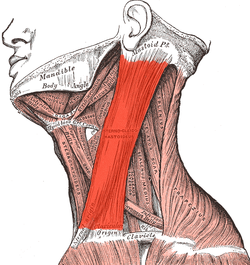| Sternocleidomastoid | |
|---|---|
 Neck muscles, with the sternocleidomastoid in bright red | |
 The sternocleidomastoid (right muscle shown) can be clearly observed when rotating the head. | |
| Details | |
| Pronunciation | (/ˌstɜːrnoʊˌklaɪdəˈmæsˌtɔɪd, -nə-, -doʊ-/[1][2]) |
| Origin | Manubrium and medial portion of the clavicle |
| Insertion | Mastoid process of the temporal bone, superior nuchal line |
| Artery | Occipital artery and the superior thyroid artery |
| Nerve | Motor: spinal accessory nerve sensory: cervical plexus Proprioceptive: ventral rami of C2-3 |
| Actions | Unilaterally: contralateral cervical rotation, ipsilateral cervical flexion Bilaterally: cervical flexion, elevation of sternum and assists in forced inhalation. |
| Identifiers | |
| Latin | musculus sternocleidomastoideus |
| TA98 | A04.2.01.008 |
| TA2 | 2156 |
| FMA | 13407 |
| Anatomical terms of muscle | |
The sternocleidomastoid muscle is one of the largest and most superficial cervical muscles. The primary actions of the muscle are rotation of the head to the opposite side and flexion of the neck.[3] The sternocleidomastoid is innervated by the accessory nerve.[3]
- ^ "Sternocleidomastoid". Merriam-Webster.com Dictionary. Merriam-Webster. Retrieved 2016-01-21.
- ^ "Sternocleidomastoid". Lexico UK English Dictionary. Oxford University Press. Archived from the original on 2020-03-22.
- ^ a b Kohan, Emil J.; Wirth, Garrett A. (2014). "Anatomy of the neck". Clinics in Plastic Surgery. 41 (1): 1–6. doi:10.1016/j.cps.2013.09.016. ISSN 1558-0504. PMID 24295343.